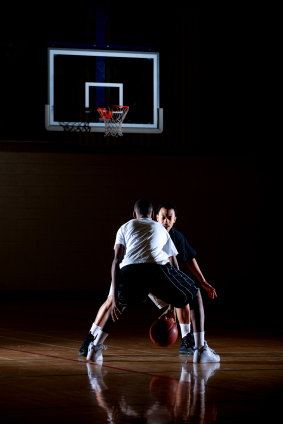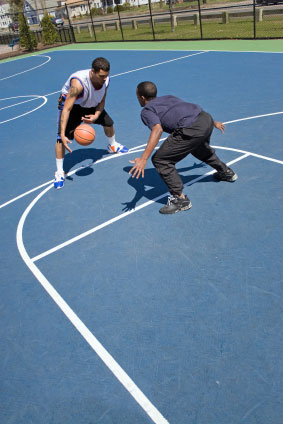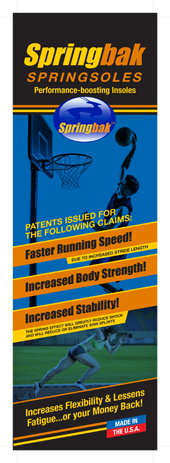Author Archive
Springbak Volleyball Conditioning Drills: What Kind of Training is Needed?
Posted by: | CommentsStrength/Power Training – How to Gain Strength for Volleyball?
 Beginning volleyball players are able to gain strength by working out with the body weight, but in order to get to the next level athletes need to start weight training.
Beginning volleyball players are able to gain strength by working out with the body weight, but in order to get to the next level athletes need to start weight training.
One of the best methods to get strength is the basic weight training in the gym. Traditional weight lifting exercises like squats, deadlifts, clean and jerk, snatches, bench press and all the variations of them are great exercises for volleyball players.
Weight training doesn’t necessary mean traditional weight lifting. It could include training with medicine balls, kettle bells or any extra weight you can imagine.
Pure Power Alone Is Not Enough
Pure power and strength alone doesn’t carry very far on the volleyball court – volleyball players also need endurance, agility and quickness on the court.
Being Explosive and Quick Is Important
When working out it is extremely important to keep in mind what qualities is needed in volleyball.
For example being explosive and quick is important for volleyball players, therefore an athete should always have explosive power training or quickness training in the training schedule.
Volleyball Conditioning Drills – Endurance Training
What kind of conditioning is needed in volleyball?
Let’s think about the volleyball match – each rally is about 5-15 seconds long, following with 5-10 second break between the rallies. Wouldn’t it make sense to practice endurance in that context?
Therefore traditional cardio, like long distance running is probably not the best training for volleyball endurance. It will surely increase athletes’ VO2 max, but still there is a better way..
Engage athletes for example in plyometrics training (low impact jumps, footwork drills, ladder drills, dot drills, etc.), in which athlete works that 5-15 seconds intensively, then having a little 5-10 break between each rep. That kind of training makes athlete work out with the same energy levels than needed in volleyball.
Surely you could add also higher intensity interval training into the mix – making athletes taking for example 15 second sprints following by jogging/walking before doing another sprint. You could make that happen on the volleyball court by running volleyball suicides – making sure athletes have to change direction often, just like in the volleyball match.
Volleyball Conditioning Drills – Agility Training
How to get quick feet and become fast on the court?
Plyometric exercises involve usually to short and quick movements, which athlete performs often with own body weight in a circuit type of training.
Plyometric exercises are great way to improve agility and help athletes to change direction quickly.
Ballistic training is very close to plyometrics training and often referred as plyometrics. Explosive push ups, squat jumps, frog jumps, medicine ball throws are ballistic or plyometric exercises which are excellent for volleyball players.
Next week we will cover Spiking Fundamentals : by Hugh McCutcheon, head coach USA Volleyball
_____
For more tips and information:
Visit the Official Springbak® Website at www.springbak.net
Peak Performance Springsoles / Insoles – Run Faster, Jump Higher, Lessen Fatigue
Find us on Facebook: www.facebook.com/springbak
Follow us on Twitter: www.twitter.com/springbak
Friend us on MySpace: www.myspace.com/springbak
Tune in on YouTube: www.youtube.com/springbakinc
Springbak Basketball Training Tips – Driving to the Basket
Posted by: | CommentsArticle by William Crow – Former Professional Basketball Player / Chairman Springbak Inc.

When you drive to the basket you must normally beat two people. The first is the man that is guarding you. The second is the big man guarding the basket. How to beat the man guarding you was covered in a previous blog. The concentration here will be how to beat the big man guarding the basket. Remember driving to the basket is the best way to get to the foul line!
Here are some tips on driving to the basket:
1. Accelerate your last two steps.
2. Remember that your momentum will carry momentum on the basketball toward the basket – so flip the ball straight up in the air when accelerating to allow your momentum to carry the ball to the basket.
3. Accelerate toward a spot on the backboard away from the big man defender.
4. Flip the ball HIGH on the backboard with soft backspin so the basketball will drop down into the basket, not careen the ball off the backboard.
5. Put the ball up quick, before the defender can react. Our Springbak Springsoles will give you quicker reaction time and a quicker release. Keep a short shooting stroke, this technique was covered in a previous blog post as well.
6. If the defender is near the basket you have the option to drive past the defender and bring the basketball back to the basket off the backboard with spin.
7. Remember you have obstacles on your side:
a. One obstacle is the basket itself. If you can jump high enough to extend the basketball above the basket, the rim will act as an obstacle to the defender.
b. Also, use your body often as an obstacle. Keep your body between the basket and your defender, controlling the basketball with spin off the backboard. If the defender goes through your body to block the basketball, you will most likely get to the foul line.
c. A third option is to make contact with your body to the body of the defender going up to block your shot. After contact, regain your balance then shoot. This is another trick that will probably get you to the foul line.
Have fun and enjoy the basketball tips – William Crow / Chairman Springbak Inc.
—
For more tips and information:
Visit the Official Springbak® Website at www.springbak.net
Peak Performance Springsoles / Insoles – Run Faster, Jump Higher, Lessen Fatigue
Take Your Best Shot in the Springbak 2010 NBA Playoff Finals Prediction Challenge
Posted by: | CommentsIt’s time to take your best shot in the Springbak 2010 NBA Playoff Finals Prediction Challenge!
Springbak Inc. wants your predictions in the 2010 playoff finals series – Comments, thoughts, opinions and answers from both Laker fans and Celtic fans alike!
Springbak will be giving away One Pair of Springbak Springsoles AND a Springbak T-Shirt to the one person who predicts the outcome of the series the closest.
Your goal is to predict:
1) How many games the series will go
and
2) How many points the winning team will beat the other team by in the last game
We look forward to your comments and good luck to everyone that answers this post!
Only one vote/comment per e-mail address please.
To be eligible to win, comments must be submitted to this blog post prior to the start of the Game 4.
So, who will take the title this year?
Have fun and GOOD LUCK!
For more information:
Visit the Official Springbak® Website at www.springbak.net
Peak Performance Springsoles / Insoles – Run Faster, Jump Higher, Lessen Fatigue
Springbak Running Tips – Lactate Threshold and Endurance Training
Posted by: | CommentsResearch and World Class Runners say:
Lactate is produced as a side reaction in a metabolic process called glycolosis. Glycolosis is the body’s energy system that breaks down carbohydrates (glucose) that are stored in muscle and liver to produce energy. Lactate IS NOT the cause of acidosis-that burning sensation we all feel in our muscle-but rather it is the byproduct of glucose breakdown during intense exercise. So lactate is actually an indirect measure of acidosis or muscle fatigue.
Your Lactate Threshold (LT) is a marker showing how much exercise (or physical work) you can sustain before the evidences of glycolosis are present. More importantly LT is that point in your exercise level where you begin to accumulate lactate in the blood and breathing becomes noticeably more labored (ventilatory changes). Your LT usually corresponds to your best 15K or 10 mile running pace or a 40K running time trial on a road bike.
Your LT can be evaluated by several methods that include monitoring your heart rate, oxygen consumption and Power output or speed at LT. With appropriate training technique you can increase your LT which will enhance your body’s ability to increase energy production through mitochondrial respirations (or more aerobic pathways) thus decreasing the reliance on energy from glycosis (anerobic). Which means you can spare your glycogen(your bodies stores carbohydrates) which are in limited supply compared to the large amount of energy you have available from fat storage.
Additionally, smart endurance training will improve your acidosis-buffering effect, thereby decreasing fatigue allowing for a longer tolerance of challenging workouts and an enhanced training effect allowing for even more intense training. Here are some recommendations from world class athletes and trainers that use Springbak Springsoles in their training programs on how to improve your Lactate Threshold.
1) An intense workout that is slightly above your LT is considered by most researchers and runners to be the best method for boosting LT.
2) 20 minutes or more of training at a heart rate just above the LT is enough to increase LT.
3) Lactate Threshold tends to be higher in older runners with one study showing the average LT at 85% of MaxVO2 for younger. Keep in mind that MaxVO2 scores are lower in the older athletes since they tend to decline with age.
4) Research suggests that training programs that are a combination of high volume, interval and steady-state workouts have the most pronounced effect on lactate threshold improvement.
Enjoy the running tips and have fun!
Mark Vona – GM Springbak Inc.
—
For more tips and information:
Visit the Official Springbak® Website at www.springbak.net
Peak Performance Springsoles / Insoles – Run Faster, Jump Higher, Lessen Fatigue
Springbak Basketball Training Tips – Inside & Outside Offensive Foot Stance
Posted by: | CommentsArticle by William Crow – Former Professional Basketball Player and Chairman Springbak Inc.
 * Outside Foot Stance:
* Outside Foot Stance:
1) Always have one foot forward in a driving stance.
2) Have the same foot forward as the shooting hand and at the same time have the basketball up to your chest.
Why? This way the offensive player has created three options.
a) He or she has put themselves in a driving position. This will cause the defender to back off to protect against a drive to the basket.
b) The offensive player option two is to shoot directly off the front leg with one upward shooting motion from the chest.
c) The offensive player can step back to create space from the defender and jump off both legs for a jump shot.
* Inside Foot Stance:
Same principal as the Outside Stance, always have one foot forward, never parallel. Why?
1) The offensive player can better hold his or her ground against a defender, because he or she can push back with the forward leg.
2) The offensive player can step away from the defender and half pivot at the same time to create space for a jump shot.
3) If forward foot position is set before receiving a pass THEN EITHER FOOT CAN BE A PIVOT FOOT. This has tremendous advantages in that the inside player can pivot either away from the basket and the defender to create space or pivot toward the basket on a drive. The defender has a much tougher time defending these two options.
4) Again, never have your feet parallel, why?
a) The option of pivoting away to create space is lost.
b) Power is lost on a drive to the basket.
c) It is much harder for the offensive player to hold position.
Have fun and enjoy the Foot Work Tips!
– William Crow, Chairman – Springbak Inc.
________________________
For more tips and information:
Visit the Official Springbak® Website at www.springbak.net
Peak Performance Springsoles / Insoles – Run Faster, Jump Higher, Lessen Fatigue























